

Compact Muon Solenoid
LHC, CERN
| CMS-BPH-22-001 ; CERN-EP-2024-172 | ||
| Measurement of the $ \mathrm{B}_{s}^{0} \to \mathrm{J}/\psi\mathrm{K^0_S} $ effective lifetime from proton-proton collisions at $ \sqrt{s} = $ 13 TeV | ||
| CMS Collaboration | ||
| 18 July 2024 | ||
| JHEP 10 (2024) 247 | ||
| Abstract: The effective lifetime of the $ \mathrm{B}_{s}^{0} $ meson in the decay $ \mathrm{B}_{s}^{0} \to \mathrm{J}/\psi\mathrm{K^0_S} $ is measured using data collected during 2016-2018 with the CMS detector in $ \sqrt{s}= $ 13 TeV proton-proton collisions at the LHC, corresponding to an integrated luminosity of 140 fb$ ^{-1} $. The effective lifetime is determined by performing a two-dimensional unbinned maximum likelihood fit to the $ \mathrm{B}_{s}^{0} $ meson invariant mass and proper decay time distributions. The resulting value of 1.59 $ \pm $ 0.07 (stat) $ \pm $ 0.03 (syst) ps is the most precise measurement to date and is in good agreement with the expected value. | ||
| Links: e-print arXiv:2407.13441 [hep-ex] (PDF) ; CDS record ; inSPIRE record ; HepData record ; CADI line (restricted) ; | ||
| Figures | |

png pdf |
Figure 1:
The tree-level (left) and penguin (right) Feynman diagrams for the decays $ {\mathrm{B}^0} \to \mathrm{J}/\psi\mathrm{K^0_S} $ and $ \mathrm{B}_{s}^{0} \to \mathrm{J}/\psi\mathrm{K^0_S} $. |
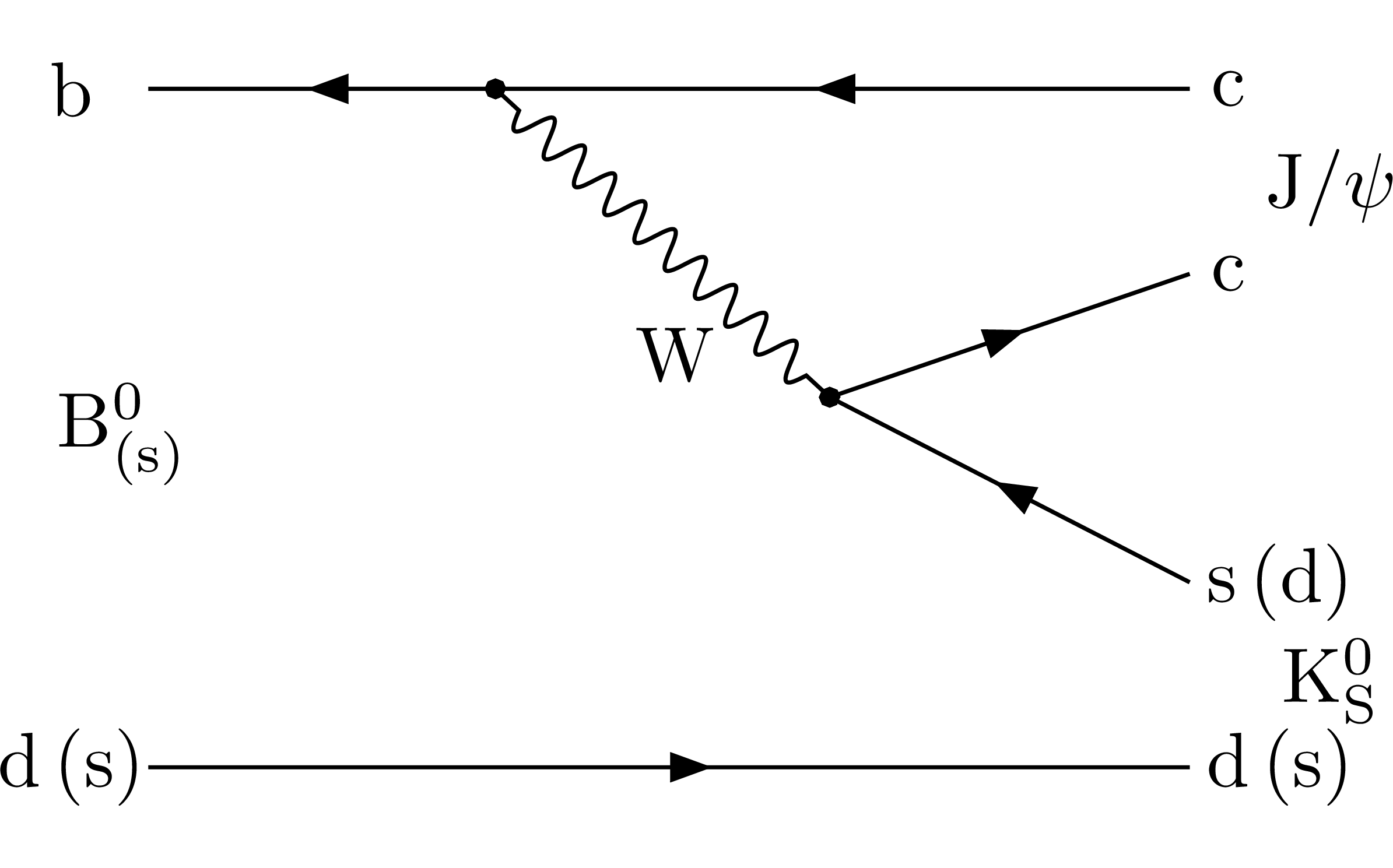
png pdf |
Figure 1-a:
The tree-level (left) and penguin (right) Feynman diagrams for the decays $ {\mathrm{B}^0} \to \mathrm{J}/\psi\mathrm{K^0_S} $ and $ \mathrm{B}_{s}^{0} \to \mathrm{J}/\psi\mathrm{K^0_S} $. |
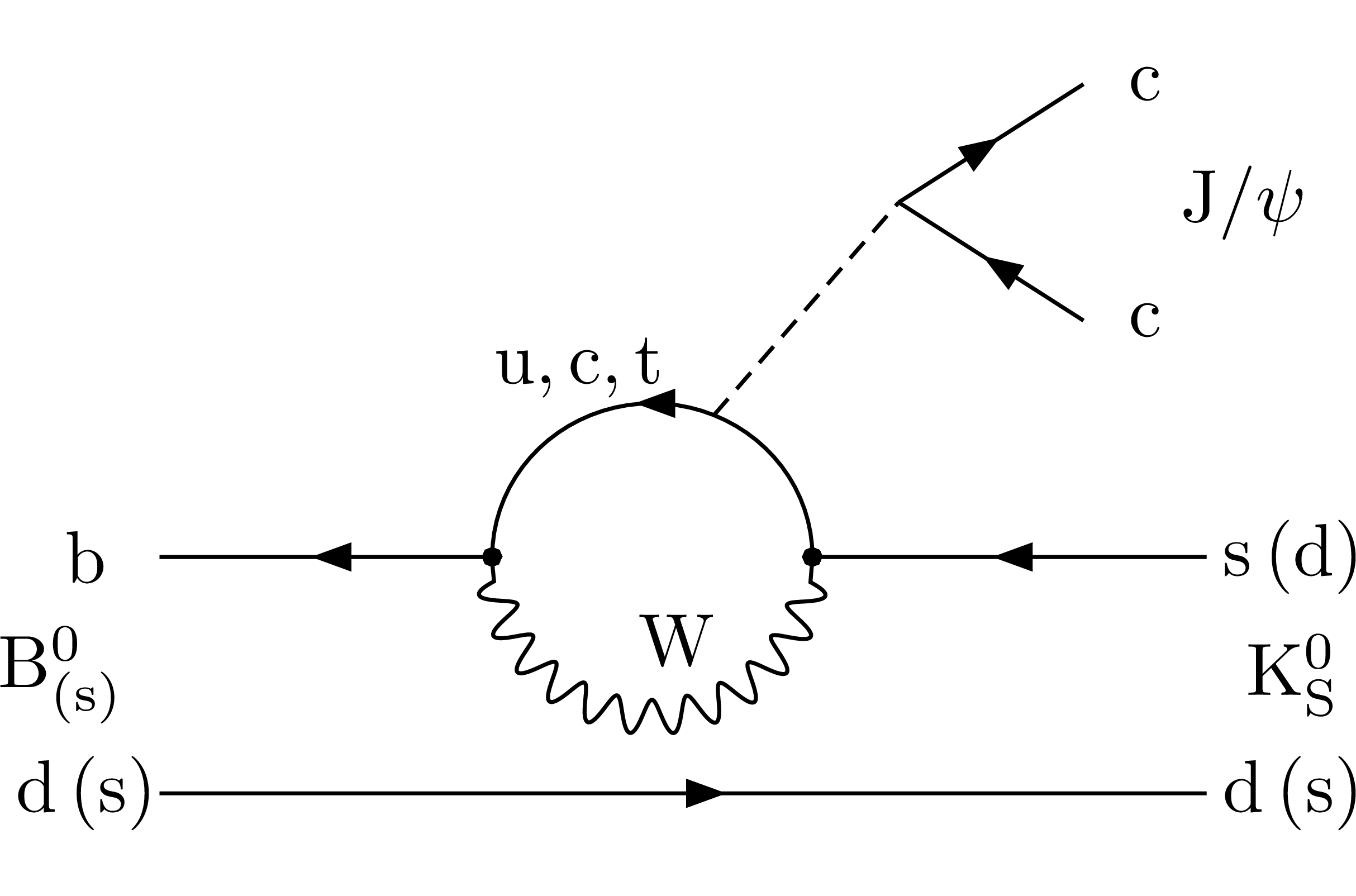
png pdf |
Figure 1-b:
The tree-level (left) and penguin (right) Feynman diagrams for the decays $ {\mathrm{B}^0} \to \mathrm{J}/\psi\mathrm{K^0_S} $ and $ \mathrm{B}_{s}^{0} \to \mathrm{J}/\psi\mathrm{K^0_S} $. |
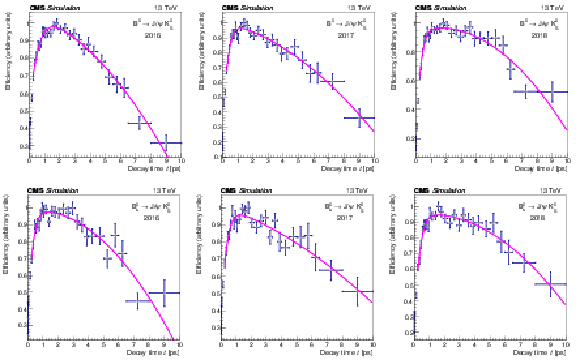
png pdf |
Figure 2:
The signal efficiency as a function of the decay time for the $ {\mathrm{B}^0} \to \mathrm{J}/\psi\mathrm{K^0_S} $ (upper) and $ \mathrm{B}_{s}^{0} \to \mathrm{J}/\psi\mathrm{K^0_S} $ (lower) decays from simulation for each of the three data-taking years. The vertical bars indicate the statistical uncertainty, and the horizontal bars give bin widths. The curves show the fit results. |
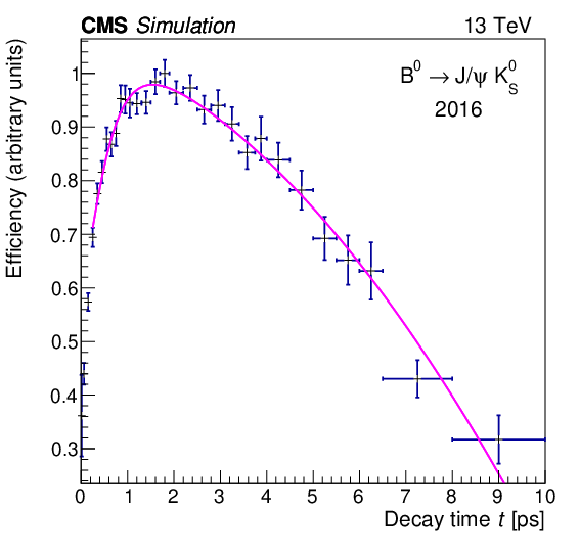
png pdf |
Figure 2-a:
The signal efficiency as a function of the decay time for the $ {\mathrm{B}^0} \to \mathrm{J}/\psi\mathrm{K^0_S} $ (upper) and $ \mathrm{B}_{s}^{0} \to \mathrm{J}/\psi\mathrm{K^0_S} $ (lower) decays from simulation for each of the three data-taking years. The vertical bars indicate the statistical uncertainty, and the horizontal bars give bin widths. The curves show the fit results. |
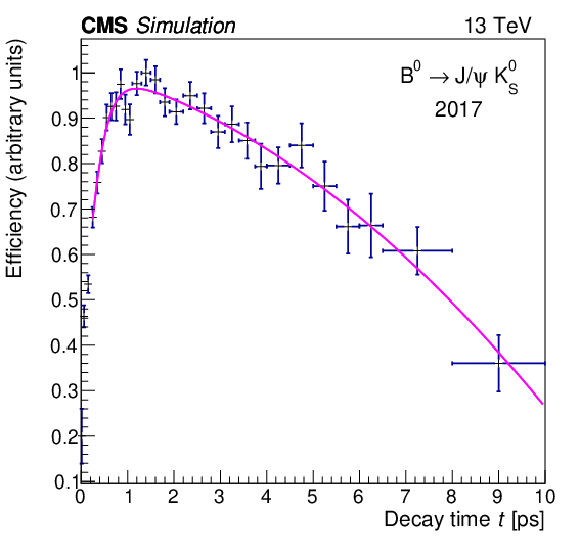
png pdf |
Figure 2-b:
The signal efficiency as a function of the decay time for the $ {\mathrm{B}^0} \to \mathrm{J}/\psi\mathrm{K^0_S} $ (upper) and $ \mathrm{B}_{s}^{0} \to \mathrm{J}/\psi\mathrm{K^0_S} $ (lower) decays from simulation for each of the three data-taking years. The vertical bars indicate the statistical uncertainty, and the horizontal bars give bin widths. The curves show the fit results. |

png pdf |
Figure 2-c:
The signal efficiency as a function of the decay time for the $ {\mathrm{B}^0} \to \mathrm{J}/\psi\mathrm{K^0_S} $ (upper) and $ \mathrm{B}_{s}^{0} \to \mathrm{J}/\psi\mathrm{K^0_S} $ (lower) decays from simulation for each of the three data-taking years. The vertical bars indicate the statistical uncertainty, and the horizontal bars give bin widths. The curves show the fit results. |

png pdf |
Figure 2-d:
The signal efficiency as a function of the decay time for the $ {\mathrm{B}^0} \to \mathrm{J}/\psi\mathrm{K^0_S} $ (upper) and $ \mathrm{B}_{s}^{0} \to \mathrm{J}/\psi\mathrm{K^0_S} $ (lower) decays from simulation for each of the three data-taking years. The vertical bars indicate the statistical uncertainty, and the horizontal bars give bin widths. The curves show the fit results. |

png pdf |
Figure 2-e:
The signal efficiency as a function of the decay time for the $ {\mathrm{B}^0} \to \mathrm{J}/\psi\mathrm{K^0_S} $ (upper) and $ \mathrm{B}_{s}^{0} \to \mathrm{J}/\psi\mathrm{K^0_S} $ (lower) decays from simulation for each of the three data-taking years. The vertical bars indicate the statistical uncertainty, and the horizontal bars give bin widths. The curves show the fit results. |

png pdf |
Figure 2-f:
The signal efficiency as a function of the decay time for the $ {\mathrm{B}^0} \to \mathrm{J}/\psi\mathrm{K^0_S} $ (upper) and $ \mathrm{B}_{s}^{0} \to \mathrm{J}/\psi\mathrm{K^0_S} $ (lower) decays from simulation for each of the three data-taking years. The vertical bars indicate the statistical uncertainty, and the horizontal bars give bin widths. The curves show the fit results. |
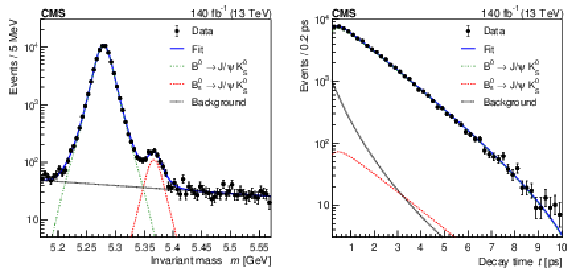
png pdf |
Figure 3:
Distributions of the $ \mathrm{J}/\psi\mathrm{K^0_S} $ invariant mass (left) and proper decay time (right) from data (points) and the results from the 2D UML fit projections (lines) for the 2016-2018 data set. The vertical bars on the data points indicate the statistical uncertainty. The solid, dotted-dashed, dashed, and dotted lines show the total fit, $ {\mathrm{B}^0} $ control channel, $ \mathrm{B}_{s}^{0} $ signal, and background contributions, respectively. |

png pdf |
Figure 3-a:
Distributions of the $ \mathrm{J}/\psi\mathrm{K^0_S} $ invariant mass (left) and proper decay time (right) from data (points) and the results from the 2D UML fit projections (lines) for the 2016-2018 data set. The vertical bars on the data points indicate the statistical uncertainty. The solid, dotted-dashed, dashed, and dotted lines show the total fit, $ {\mathrm{B}^0} $ control channel, $ \mathrm{B}_{s}^{0} $ signal, and background contributions, respectively. |

png pdf |
Figure 3-b:
Distributions of the $ \mathrm{J}/\psi\mathrm{K^0_S} $ invariant mass (left) and proper decay time (right) from data (points) and the results from the 2D UML fit projections (lines) for the 2016-2018 data set. The vertical bars on the data points indicate the statistical uncertainty. The solid, dotted-dashed, dashed, and dotted lines show the total fit, $ {\mathrm{B}^0} $ control channel, $ \mathrm{B}_{s}^{0} $ signal, and background contributions, respectively. |

png pdf |
Figure 4:
The proper decay time distribution from data (points) for events in the $ \mathrm{B}_{s}^{0} $ signal region with $ \mathrm{J}/\psi\mathrm{K^0_S} $ invariant mass in the range 5.34-5.42 GeV and the results from the 2D UML fit projections (lines) for the 2016-2018 data set. The vertical bars on the data points indicate the statistical uncertainty. The dashed, dotted-dashed, dotted, and solid lines show the $ \mathrm{B}_{s}^{0} $ signal, $ {\mathrm{B}^0} $ control channel, background, and total fit contributions, respectively. |

png pdf |
Figure 5:
Distributions of the $ \mathrm{J}/\psi\mathrm{K^0_S} $ invariant mass (upper) and decay time (lower) from data (points), along with the projections from the 2D UML fit for each year of data taking. The vertical bars on the data points indicate the statistical uncertainty. The dashed, dotted-dashed, dotted, and solid lines represent the signal, control channel, background, and total fit contributions, respectively. |

png pdf |
Figure 5-a:
Distributions of the $ \mathrm{J}/\psi\mathrm{K^0_S} $ invariant mass (upper) and decay time (lower) from data (points), along with the projections from the 2D UML fit for each year of data taking. The vertical bars on the data points indicate the statistical uncertainty. The dashed, dotted-dashed, dotted, and solid lines represent the signal, control channel, background, and total fit contributions, respectively. |

png pdf |
Figure 5-b:
Distributions of the $ \mathrm{J}/\psi\mathrm{K^0_S} $ invariant mass (upper) and decay time (lower) from data (points), along with the projections from the 2D UML fit for each year of data taking. The vertical bars on the data points indicate the statistical uncertainty. The dashed, dotted-dashed, dotted, and solid lines represent the signal, control channel, background, and total fit contributions, respectively. |

png pdf |
Figure 5-c:
Distributions of the $ \mathrm{J}/\psi\mathrm{K^0_S} $ invariant mass (upper) and decay time (lower) from data (points), along with the projections from the 2D UML fit for each year of data taking. The vertical bars on the data points indicate the statistical uncertainty. The dashed, dotted-dashed, dotted, and solid lines represent the signal, control channel, background, and total fit contributions, respectively. |

png pdf |
Figure 5-d:
Distributions of the $ \mathrm{J}/\psi\mathrm{K^0_S} $ invariant mass (upper) and decay time (lower) from data (points), along with the projections from the 2D UML fit for each year of data taking. The vertical bars on the data points indicate the statistical uncertainty. The dashed, dotted-dashed, dotted, and solid lines represent the signal, control channel, background, and total fit contributions, respectively. |

png pdf |
Figure 5-e:
Distributions of the $ \mathrm{J}/\psi\mathrm{K^0_S} $ invariant mass (upper) and decay time (lower) from data (points), along with the projections from the 2D UML fit for each year of data taking. The vertical bars on the data points indicate the statistical uncertainty. The dashed, dotted-dashed, dotted, and solid lines represent the signal, control channel, background, and total fit contributions, respectively. |

png pdf |
Figure 5-f:
Distributions of the $ \mathrm{J}/\psi\mathrm{K^0_S} $ invariant mass (upper) and decay time (lower) from data (points), along with the projections from the 2D UML fit for each year of data taking. The vertical bars on the data points indicate the statistical uncertainty. The dashed, dotted-dashed, dotted, and solid lines represent the signal, control channel, background, and total fit contributions, respectively. |

png pdf |
Figure 6:
The decay time distribution for events with $ \mathrm{J}/\psi\mathrm{K^0_S} $ invariant mass in the range 5.17 $ < m < $ 5.22 (upper), 5.22 $ < m < $ 5.34 (center), and 5.42 $ < m < $ 5.57 (lower) GeV and the fit results for the 2016 (left), 2017 (middle), and 2018 (right) data-taking years. |

png pdf |
Figure 6-a:
The decay time distribution for events with $ \mathrm{J}/\psi\mathrm{K^0_S} $ invariant mass in the range 5.17 $ < m < $ 5.22 (upper), 5.22 $ < m < $ 5.34 (center), and 5.42 $ < m < $ 5.57 (lower) GeV and the fit results for the 2016 (left), 2017 (middle), and 2018 (right) data-taking years. |

png pdf |
Figure 6-b:
The decay time distribution for events with $ \mathrm{J}/\psi\mathrm{K^0_S} $ invariant mass in the range 5.17 $ < m < $ 5.22 (upper), 5.22 $ < m < $ 5.34 (center), and 5.42 $ < m < $ 5.57 (lower) GeV and the fit results for the 2016 (left), 2017 (middle), and 2018 (right) data-taking years. |

png pdf |
Figure 6-c:
The decay time distribution for events with $ \mathrm{J}/\psi\mathrm{K^0_S} $ invariant mass in the range 5.17 $ < m < $ 5.22 (upper), 5.22 $ < m < $ 5.34 (center), and 5.42 $ < m < $ 5.57 (lower) GeV and the fit results for the 2016 (left), 2017 (middle), and 2018 (right) data-taking years. |

png pdf |
Figure 6-d:
The decay time distribution for events with $ \mathrm{J}/\psi\mathrm{K^0_S} $ invariant mass in the range 5.17 $ < m < $ 5.22 (upper), 5.22 $ < m < $ 5.34 (center), and 5.42 $ < m < $ 5.57 (lower) GeV and the fit results for the 2016 (left), 2017 (middle), and 2018 (right) data-taking years. |

png pdf |
Figure 6-e:
The decay time distribution for events with $ \mathrm{J}/\psi\mathrm{K^0_S} $ invariant mass in the range 5.17 $ < m < $ 5.22 (upper), 5.22 $ < m < $ 5.34 (center), and 5.42 $ < m < $ 5.57 (lower) GeV and the fit results for the 2016 (left), 2017 (middle), and 2018 (right) data-taking years. |

png pdf |
Figure 6-f:
The decay time distribution for events with $ \mathrm{J}/\psi\mathrm{K^0_S} $ invariant mass in the range 5.17 $ < m < $ 5.22 (upper), 5.22 $ < m < $ 5.34 (center), and 5.42 $ < m < $ 5.57 (lower) GeV and the fit results for the 2016 (left), 2017 (middle), and 2018 (right) data-taking years. |

png pdf |
Figure 6-g:
The decay time distribution for events with $ \mathrm{J}/\psi\mathrm{K^0_S} $ invariant mass in the range 5.17 $ < m < $ 5.22 (upper), 5.22 $ < m < $ 5.34 (center), and 5.42 $ < m < $ 5.57 (lower) GeV and the fit results for the 2016 (left), 2017 (middle), and 2018 (right) data-taking years. |

png pdf |
Figure 6-h:
The decay time distribution for events with $ \mathrm{J}/\psi\mathrm{K^0_S} $ invariant mass in the range 5.17 $ < m < $ 5.22 (upper), 5.22 $ < m < $ 5.34 (center), and 5.42 $ < m < $ 5.57 (lower) GeV and the fit results for the 2016 (left), 2017 (middle), and 2018 (right) data-taking years. |

png pdf |
Figure 6-i:
The decay time distribution for events with $ \mathrm{J}/\psi\mathrm{K^0_S} $ invariant mass in the range 5.17 $ < m < $ 5.22 (upper), 5.22 $ < m < $ 5.34 (center), and 5.42 $ < m < $ 5.57 (lower) GeV and the fit results for the 2016 (left), 2017 (middle), and 2018 (right) data-taking years. |

png pdf |
Figure 7:
The invariant mass distribution for events with $ \mathrm{J}/\psi\mathrm{K^0_S} $ decay time in the range 0.2 $ < t < $ 2.5 (upper), 2.5 $ < t < $ 3.5 (center), and 3.5 $ < t < $ 10.0 (lower)\unitps and the fit results for the 2016 (left), 2017 (middle), and 2018 (right) data-taking years. |

png pdf |
Figure 7-a:
The invariant mass distribution for events with $ \mathrm{J}/\psi\mathrm{K^0_S} $ decay time in the range 0.2 $ < t < $ 2.5 (upper), 2.5 $ < t < $ 3.5 (center), and 3.5 $ < t < $ 10.0 (lower)\unitps and the fit results for the 2016 (left), 2017 (middle), and 2018 (right) data-taking years. |

png pdf |
Figure 7-b:
The invariant mass distribution for events with $ \mathrm{J}/\psi\mathrm{K^0_S} $ decay time in the range 0.2 $ < t < $ 2.5 (upper), 2.5 $ < t < $ 3.5 (center), and 3.5 $ < t < $ 10.0 (lower)\unitps and the fit results for the 2016 (left), 2017 (middle), and 2018 (right) data-taking years. |

png pdf |
Figure 7-c:
The invariant mass distribution for events with $ \mathrm{J}/\psi\mathrm{K^0_S} $ decay time in the range 0.2 $ < t < $ 2.5 (upper), 2.5 $ < t < $ 3.5 (center), and 3.5 $ < t < $ 10.0 (lower)\unitps and the fit results for the 2016 (left), 2017 (middle), and 2018 (right) data-taking years. |

png pdf |
Figure 7-d:
The invariant mass distribution for events with $ \mathrm{J}/\psi\mathrm{K^0_S} $ decay time in the range 0.2 $ < t < $ 2.5 (upper), 2.5 $ < t < $ 3.5 (center), and 3.5 $ < t < $ 10.0 (lower)\unitps and the fit results for the 2016 (left), 2017 (middle), and 2018 (right) data-taking years. |

png pdf |
Figure 7-e:
The invariant mass distribution for events with $ \mathrm{J}/\psi\mathrm{K^0_S} $ decay time in the range 0.2 $ < t < $ 2.5 (upper), 2.5 $ < t < $ 3.5 (center), and 3.5 $ < t < $ 10.0 (lower)\unitps and the fit results for the 2016 (left), 2017 (middle), and 2018 (right) data-taking years. |

png pdf |
Figure 7-f:
The invariant mass distribution for events with $ \mathrm{J}/\psi\mathrm{K^0_S} $ decay time in the range 0.2 $ < t < $ 2.5 (upper), 2.5 $ < t < $ 3.5 (center), and 3.5 $ < t < $ 10.0 (lower)\unitps and the fit results for the 2016 (left), 2017 (middle), and 2018 (right) data-taking years. |

png pdf |
Figure 7-g:
The invariant mass distribution for events with $ \mathrm{J}/\psi\mathrm{K^0_S} $ decay time in the range 0.2 $ < t < $ 2.5 (upper), 2.5 $ < t < $ 3.5 (center), and 3.5 $ < t < $ 10.0 (lower)\unitps and the fit results for the 2016 (left), 2017 (middle), and 2018 (right) data-taking years. |

png pdf |
Figure 7-h:
The invariant mass distribution for events with $ \mathrm{J}/\psi\mathrm{K^0_S} $ decay time in the range 0.2 $ < t < $ 2.5 (upper), 2.5 $ < t < $ 3.5 (center), and 3.5 $ < t < $ 10.0 (lower)\unitps and the fit results for the 2016 (left), 2017 (middle), and 2018 (right) data-taking years. |

png pdf |
Figure 7-i:
The invariant mass distribution for events with $ \mathrm{J}/\psi\mathrm{K^0_S} $ decay time in the range 0.2 $ < t < $ 2.5 (upper), 2.5 $ < t < $ 3.5 (center), and 3.5 $ < t < $ 10.0 (lower)\unitps and the fit results for the 2016 (left), 2017 (middle), and 2018 (right) data-taking years. |
| Tables | |
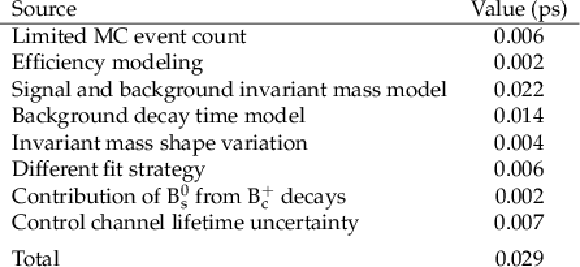
png pdf |
Table 1:
Sources of systematic uncertainties in the $ \mathrm{B}_{s}^{0} \to \mathrm{J}/\psi\mathrm{K^0_S} $ effective lifetime measurement and their estimated values, along with the total systematic uncertainty. |
| Summary |
| In this paper, a measurement of the effective lifetime of the $ \mathrm{B}_{s}^{0} $ meson in the $ \mathrm{J}/\psi\mathrm{K^0_S} $ decay channel is presented. The analysis is performed using data collected by the CMS detector during proton-proton collisions at a center-of-mass energy of 13 TeV from 2016 to 2018, corresponding to an integrated luminosity of 140 fb$ ^{-1} $. The effective lifetime is extracted using a two-dimensional unbinned maximum likelihood fit to the invariant mass and proper decay time distributions of the $ \mathrm{B}_{s}^{0} $ meson. The decay $ {\mathrm{B}^0} \to \mathrm{J}/\psi\mathrm{K^0_S} $, which has a much larger event yield than the corresponding $ \mathrm{B}_{s}^{0} $ decay, is used as a control channel for estimating resolutions and systematic uncertainties. The measured value of the effective lifetime is $ \tau(\mathrm{B}_{s}^{0} \to \mathrm{J}/\psi\mathrm{K^0_S}) = $ 1.59 $ \pm $ 0.07 (stat) $ \pm $ 0.03 (syst) ps, which is the most precise result to date. This measurement can be used to constrain the parameters that govern mixing and CP violation in the $ \mathrm{B}_{s}^{0} $ system and also to better understand the penguin contributions in measurements of $ \sin{(2\beta)} $ from $ {\mathrm{B}^0} \to \mathrm{J}/\psi\mathrm{K^0_S} $ decays. |
| References | ||||
| 1 | J. Albrecht, F. Bernlochner, A. Lenz, and A. Rusov | Lifetimes of b-hadrons and mixing of neutral B-mesons: theoretical and experimental status | Eur. Phys. J. ST 233 (2024) 359 | 2402.04224 |
| 2 | N. Cabibbo | Unitary symmetry and leptonic decays | PRL 10 (1963) 531 | |
| 3 | M. Kobayashi and T. Maskawa | $ C\hspace{-.08em}P $ violation in the renormalizable theory of weak interaction | Prog. Theor. Phys. 49 (1973) 652 | |
| 4 | M. Ciuchini, M. Pierini, and L. Silvestrini | Effect of penguin operators in the $ {\mathrm{B}^0} \to \mathrm{J}/\psi \mathrm{K}^0 C\hspace{-.08em}P $ asymmetry | PRL 95 (2005) 221804 | hep-ph/0507290 |
| 5 | S. Faller, M. Jung, R. Fleischer, and T. Mannel | The golden modes $ {\mathrm{B}^0} \to \mathrm{J}/\psi \mathrm{K}_\mathrm{S,L} $ in the era of precision flavour physics | PRD 79 (2009) 014030 | 0809.0842 |
| 6 | M. Jung | Determining weak phases from $ \mathrm{B} \to \mathrm{J}/\psi P $ decays | PRD 86 (2012) 053008 | 1206.2050 |
| 7 | P. Frings, U. Nierste, and M. Wiebusch | Penguin contributions to $ C\hspace{-.08em}P $ phases in $ \mathrm{B}_\mathrm{d,s} $ decays to charmonium | PRL 115 (2015) 061802 | 1503.00859 |
| 8 | LHCb Collaboration | Measurement of $ C\hspace{-.08em}P $ violation in $ {\mathrm{B}^0} \to \psi( \to l^{+}l^{-}) \mathrm{K^0_S}( \to \pi^{+}\pi^{-}) $ decays | PRL 132 (2024) 021801 | 2309.09728 |
| 9 | R. Fleischer | Recent theoretical developments in $ C\hspace{-.08em}P $ violation in the B system | NIM A 446 (2000) 1 | hep-ph/9908340 |
| 10 | K. De Bruyn, R. Fleischer, and P. Koppenburg | Extracting $ \gamma $ and penguin topologies through $ C\hspace{-.08em}P $ violation in $ \mathrm{B}_{s}^{0} \to \mathrm{J}/\psi\mathrm{K^0_S} $ | EPJC 70 (2010) 1025 | 1010.0089 |
| 11 | K. De Bruyn and R. Fleischer | A roadmap to control penguin effects in $ \mathrm{B}_\mathrm{d}^0 \to \mathrm{J}/\psi\mathrm{K^0_S} $ and $ \mathrm{B}_{s}^{0} \to \mathrm{J}/\psi \phi $ | JHEP 03 (2015) 145 | 1412.6834 |
| 12 | M. Z. Barel, K. De Bruyn, R. Fleischer, and E. Malami | In pursuit of new physics with $ \mathrm{B}_\mathrm{d}^0 \to \mathrm{J}/\psi {\mathrm{k}^0} $ and $ \mathrm{B}_{s}^{0} \to \mathrm{J}/\psi \phi $ decays at the high-precision frontier | JPG 48 (2021) 065002 | 2010.14423 |
| 13 | M. Z. Barel, K. De Bruyn, R. Fleischer, and E. Malami | Penguin effects in $ \mathrm{B}_\mathrm{d}^0 \to \mathrm{J}/\psi\mathrm{K^0_S} $ and $ \mathrm{B}_{s}^{0} \to \mathrm{J}/\psi \phi $ | PoS CKM 111, 2023 link |
2203.14652 |
| 14 | K. De Bruyn et al. | Branching ratio measurements of $ \mathrm{B}_{s}^{0} $ decays | PRD 86 (2012) 014027 | 1204.1735 |
| 15 | CMS Collaboration | Measurement of the $ \mathrm{B}_{s}^{0} \to \mu^{+}\mu^{-} $ decay properties and search for the $ {\mathrm{B}^0} \to \mu^{+}\mu^{-} $ decay in proton-proton collisions at $ \sqrt{s} = $ 13 TeV | PLB 842 (2023) 137955 | CMS-BPH-21-006 2212.10311 |
| 16 | CMS Collaboration | Measurement of properties of $ \mathrm{B}_{s}^{0} \to \mu^{+}\mu^{-} $ decays and search for $ {\mathrm{B}^0} \to \mu^{+}\mu^{-} $ with the CMS experiment | JHEP 04 (2020) 188 | CMS-BPH-16-004 1910.12127 |
| 17 | CMS Collaboration | Measurement of b hadron lifetimes in pp collisions at $ \sqrt{s} = $ 8 TeV | EPJC 78 (2018) 457 | CMS-BPH-13-008 1710.08949 |
| 18 | ATLAS Collaboration | Measurement of the $ \mathrm{B}_{s}^{0} \to \mu^{+}\mu^{-} $ effective lifetime with the ATLAS detector | JHEP 09 (2023) 199 | 2308.01171 |
| 19 | LHCb Collaboration | Measurement of $ \tau_\mathrm{L} $ using the $ \mathrm{B}_{s}^{0} \to \mathrm{J}/\psi \eta $ decay mode | EPJC 83 (2023) 629 | 2206.03088 |
| 20 | LHCb Collaboration | Analysis of neutral B-meson decays into two muons | PRL 128 (2022) 041801 | 2108.09284 |
| 21 | LHCb Collaboration | Measurement of the $ \mathrm{B}_{s}^{0} \to \mu^{+}\mu^{-} $ decay properties and search for the $ {\mathrm{B}^0} \to \mu^{+}\mu^{-} $ and $ \mathrm{B}_{s}^{0} \to \mu^{+}\mu^{-}\gamma $ decays | PRD 105 (2022) 012010 | 2108.09283 |
| 22 | LHCb Collaboration | Measurement of the $ \mathrm{B}_{s}^{0} \to \mu^{+}\mu^{-} $ branching fraction and effective lifetime and search for $ {\mathrm{B}^0} \to \mu^{+}\mu^{-} $ decays | PRL 118 (2017) 191801 | 1703.05747 |
| 23 | LHCb Collaboration | Measurement of the $ \mathrm{B}_{s}^{0} \to \mathrm{J}/\psi \eta $ lifetime | PLB 762 (2016) 484 | 1607.06314 |
| 24 | LHCb Collaboration | Effective lifetime measurements in the $ \mathrm{B}_{s}^{0} \to \mathrm{K}^+\mathrm{K}^- $, $ {\mathrm{B}^0} \to \mathrm{K}^+\pi^- $ and $ \mathrm{B}_{s}^{0}\to \pi^+ \mathrm{K}^- $ decays | PLB 736 (2014) 446 | 1406.7204 |
| 25 | LHCb Collaboration | Measurements of the $ \mathrm{B}^+ $, $ \mathrm{B}^0 $, $ \mathrm{B}^0_\mathrm{s} $ meson and $ \Lambda^0_\mathrm{b} $ baryon lifetimes | JHEP 04 (2014) 114 | 1402.2554 |
| 26 | LHCb Collaboration | Measurement of the $ \overline{\mathrm{B}}_{s}^{0}\to \mathrm{D}_\mathrm{s}^-\mathrm{D}_\mathrm{s}^+ $ and $ \overline{\mathrm{B}}_{s}^{0}\to \mathrm{D}^-\mathrm{D}_\mathrm{s}^+ $ effective lifetimes | PRL 112 (2014) 111802 | 1312.1217 |
| 27 | LHCb Collaboration | Measurement of the effective $ \mathrm{B}_{s}^{0} \to \mathrm{J}/\psi\mathrm{K^0_S} $ lifetime | NPB 873 (2013) 275 | 1304.4500 |
| 28 | LHCb Collaboration | Measurement of the effective $ \mathrm{B}_{s}^{0}\to \mathrm{K}^+\mathrm{K}^- $ lifetime | PLB 707 (2012) 349 | 1111.0521 |
| 29 | LHCb Collaboration | Measurement of the $ \mathrm{B}_{s}^{0} $ effective lifetime in the $ \mathrm{J}/\psi f_0 $ final state | PRL 109 (2012) 152002 | 1207.0878 |
| 30 | LHCb Collaboration | Measurement of the effective $ \mathrm{B}_{s}^{0} \to \mathrm{K}^+\mathrm{K}^- $ lifetime | PLB 716 (2012) 393 | 1207.5993 |
| 31 | Heavy Flavor Averaging Group | Averages of b-hadron, c-hadron, and $ \tau $-lepton properties as of 2021 | PRD 107 (2023) 052008 | 2206.07501 |
| 32 | CDF Collaboration | Observation of $ B^0_s \to J/\psi K^{*0}(892) $ and $ B^0_s \to J/\psi K^0_S $ decays | PRD 83 (2011) 052012 | 1102.1961 |
| 33 | R. Fleischer and R. Knegjens | Effective lifetimes of $ \mathrm{B}_{s}^{0} $ decays and their constraints on the $ \mathrm{B}_{s}^{0}$-$\overline{\mathrm{B}}_{s}^{0} $ mixing parameters | EPJC 71 (2011) 1789 | 1109.5115 |
| 34 | Particle Data Group | Review of particle physics | PRD 110 (2024) 030001 | |
| 35 | CMS Collaboration | Description and performance of track and primary-vertex reconstruction with the CMS tracker | JINST 9 (2014) P10009 | CMS-TRK-11-001 1405.6569 |
| 36 | Tracker group of the CMS Collaboration | The CMS phase-1 pixel detector upgrade | JINST 16 (2021) P02027 | 2012.14304 |
| 37 | CMS Collaboration | Track impact parameter resolution for the full pseudo rapidity coverage in the 2017 dataset with the CMS phase-1 pixel detector | CMS Detector Performance Note CMS-DP-2020-049, 2020 CDS |
|
| 38 | CMS Collaboration | The CMS experiment at the CERN LHC | JINST 3 (2008) S08004 | |
| 39 | CMS Collaboration | Performance of the CMS Level-1 trigger in proton-proton collisions at $ \sqrt{s} = $ 13 TeV | JINST 15 (2020) P10017 | CMS-TRG-17-001 2006.10165 |
| 40 | CMS Collaboration | The CMS trigger system | JINST 12 (2017) P01020 | CMS-TRG-12-001 1609.02366 |
| 41 | CMS Collaboration | Precision luminosity measurement in proton-proton collisions at $ \sqrt{s}= $ 13 TeV in 2015 and 2016 at CMS | EPJC 81 (2021) 800 | CMS-LUM-17-003 2104.01927 |
| 42 | CMS Collaboration | CMS luminosity measurement for the 2017 data-taking period at $ \sqrt{s} = $ 13 TeV | CMS Physics Analysis Summary, 2018 link |
CMS-PAS-LUM-17-004 |
| 43 | CMS Collaboration | CMS luminosity measurement for the 2018 data-taking period at $ \sqrt{s} = $ 13 TeV | CMS Physics Analysis Summary, 2019 link |
CMS-PAS-LUM-18-002 |
| 44 | T. Sjöstrand et al. | An introduction to PYTHIA 8.2 | Comput. Phys. Commun. 191 (2015) 159 | 1410.3012 |
| 45 | D. J. Lange | The EvtGen particle decay simulation package | NIM A 462 (2001) 152 | |
| 46 | E. Barberio and Z. Was | PHOTOS --- a universal Monte Carlo for QED radiative corrections: version 2.0 | Comput. Phys. Commun. 79 (1994) 291 | |
| 47 | GEANT4 Collaboration | GEANT 4 --- a simulation toolkit | NIM A 506 (2003) 250 | |
| 48 | CMS Collaboration | Performance of the CMS muon detector and muon reconstruction with proton-proton collisions at $ \sqrt{s}= $ 13 TeV | JINST 13 (2018) P06015 | CMS-MUO-16-001 1804.04528 |
| 49 | CMS Collaboration | CMS tracking performance results from early LHC operation | EPJC 70 (2010) 1165 | CMS-TRK-10-001 1007.1988 |
| 50 | R. Frühwirth | Application of Kalman filtering to track and vertex fitting | NIM A 262 (1987) 444 | |
| 51 | J. Podolanski and R. Armenteros | Analysis of V-events | Philosophical Magazine 45 (1954) 13 | |
| 52 | J. E. Gaiser | Charmonium spectroscopy from radiative decays of $ \mathrm{J}/\psi $ and $ \psi' $ | PhD thesis, Stanford University, SLAC Report SLAC-R-255, 1982 link |
|
| 53 | N. L. Johnson | Systems of frequency curves generated by methods of translation | Biometrika 36 (1949) 149 | |
| 54 | S. Jackman | Bayesian analysis for the social sciences | John Wiley & Sons, New Jersey, USA, 2009 link |
|
| 55 | CMS Collaboration | HEPData record for this analysis | link | |

|
Compact Muon Solenoid LHC, CERN |

|

|

|

|

|

|